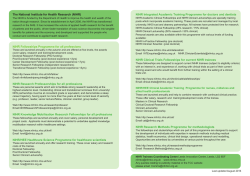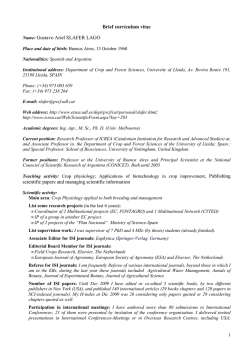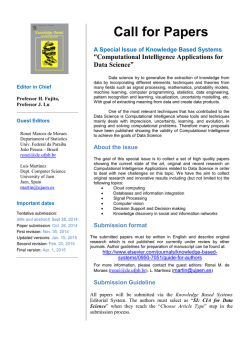
Scientific Summary - NIHR Journals Library
Secondary analysis and literature review of community rehabilitation and intermediate care: an information resource Steven M Ariss,1* Pamela M Enderby,1 Tony Smith,2 Susan A Nancarrow,3 Mike J Bradburn,1 Deborah Harrop,2 Stuart G Parker,1,4 Ann McDonnell,2 Simon Dixon,1 Tony Ryan,5 Alexandra Hayman1 and Michael Campbell1 1School of Health and Related Research, University of Sheffield, Sheffield, UK for Health and Social Care Research, Sheffield Hallam University, Sheffield, UK 3Faculty of Health and Human Sciences, Southern Cross University, Lismore, NSW, Australia 4Institute of Health and Society, Newcastle University, Newcastle upon Tyne, UK 5School of Nursing and Midwifery, University of Sheffield, Sheffield, UK 2Centre *Corresponding author Declared competing interests of authors: Stuart Parker declares National Institute for Health Research (NIHR) grants for Health Services and Delivery Research 12/5003/02 and was Deputy Director for the NIHR South Yorkshire Collaboration for Leadership in Applied Health Research and Care. Published January 2015 DOI: 10.3310/hsdr03010 Scientific summary Community rehabilitation and intermediate care Health Services and Delivery Research 2015; Vol. 3: No. 1 DOI: 10.3310/hsdr03010 NIHR Journals Library www.journalslibrary.nihr.ac.uk SCIENTIFIC SUMMARY: COMMUNITY REHABILITATION AND INTERMEDIATE CARE Scientific summary Background Despite a previous large-scale study (Barton P, Bryan S, Glasby J, Hewitt G, Jagger C, Kaambwa B, et al. A National Evaluation of the Costs and Outcomes of Intermediate Care for Older People. Birmingham and Leicester: University of Birmingham and University of Leicester; 2005), it has proved difficult to draw clear conclusions because of the heterogeneity of the teams. By merging and comparing data from our two projects [The Relationship Between Workforce Flexibility and the Costs and Outcomes of Older Peoples’ Services (COOP) study and The Impact of Enhancing the Effectiveness of Interdisciplinary Working (EEICC) study], this study aims to provide the most definitive information available to date regarding staffing models and patient outcomes. A further advantage of combining the two data sets is that it allows examination of changes over time as policies and service developments have evolved. The data were derived from two projects funded by the National Institute for Health Research (NIHR) Service Delivery and Organisation (SDO) programme: Project 1: COOP [Nancarrow SA, Enderby PM, Moran AM, Dixon S, Parker SG, Bradburn MJ, et al. The Relationship Between Workforce Flexibility and the Costs and Outcomes of Older Peoples’ Services (COOP). Southampton: NIHR SDO; 2010] was carried out between May 2005 and July 2008. It aimed to investigate how workforce policy affected service development of IC services across England and whether or not variations in organisational and management structures, as well as workforce configurations, had an impact on patient, staff and service outcomes. Project 2: EEICC [Nancarrow SA, Enderby PM, Ariss SM, Smith T, Booth A, Campbell MJ, et al. The Impact of Enhancing the Effectiveness of Interdisciplinary Working (EEICC). Southampton: NIHR SDO; 2012] aimed to examine the impact of an intervention to improve interdisciplinary working and explore the relationship between teamworking and impacts on staff and patients. Patient outcome data were collected between March 2009 and April 2011. Aims and objectives To explore, through secondary analysis of existing data, ways to enhance the effectiveness and efficiency of intermediate care services All community-based support for older people who would otherwise be admitted to hospital, or would require increased length of stay will be called intermediate care (IC) services in this report. These services are commonly staffed by a range of Allied Health Professionals (AHPs), nurses, social care staff and support workers. This research was based on reanalysis of a merged data set from two projects to identify which patient characteristics are associated with ‘good’ outcomes with IC and those for whom IC is inappropriate or who could be better managed in alternative settings. Additionally, we have examined the impact of different team and staffing structures on patient outcomes and service costs to identify the most cost-effective service configurations. The research reported was also informed by a series of systematic literature reviews focused on the specific research objectives in each chapter. ii NIHR Journals Library www.journalslibrary.nihr.ac.uk HEALTH SERVICES AND DELIVERY RESEARCH 2015 VOL. 3 NO. 1 (SCIENTIFIC SUMMARY) Objectives 1. To identify those patients most likely to benefit from IC and those who would be best placed to receive care elsewhere. 2. To examine the effectiveness of different models of IC. 3. To explore the differences between IC service configurations and how they have changed over time. 4. To use the findings above to develop accessible evidence to guide service commissioning and monitoring. Our unique data sets contain data on 8070 patient admissions from 32 IC teams across England and include details of the service context, costs, staffing/skill mix (800 staff), patient health status and outcomes. Data collected Both projects collected literature review, service, team and patient data. Literature review Systematic reviews that were undertaken in the previous studies were updated (see Results summary) and informed by Walker and Avant’s approach to concept analysis (Walker LO, Avant KC. Strategies for Theory Construction in Nursing. Upper Saddle River, NJ: Pearson/Prentice Hall; 2005). The following databases were searched on 21 December 2011, 23 March 2012, 10 April 2012 and 12 April 2012: l l l MEDLINE (via EBSCOhost) Cumulative Index to Nursing and Allied Health Literature (CINAHL; via EBSCOhost) Applied Social Sciences Index and Abstracts (ASSIA; via ProQuest); Chapter 4 only. Results summary Database hits Chapter CINAHL MEDLINE ASSIA Number of duplicates Chapter 1 828 981 N/A 1560 Chapter 2 712 1512 N/A 1884 Chapter 3 837 30 N/A 859 Chapter 4 299 408 N/A 633 Chapter 4 387 332 N/A 624 Chapter 5 165 293 N/A 404 Chapter 5 (additional search) 57 44 N/A 93 Chapter 7 1308 1552 N/A 2176 Chapter 8 11 14 N/A 16 Chapter 9 768 1413 72 1516 Chapter 9 (UK only) 81 150 27 208 N/A, not applicable. All searches have been written up for MEDLINE using the EBSCOhost interface. Service data Each team provided information relating to the size, nature, staffing and resourcing of the services. The service pro forma was developed through a systematic literature review and piloted in regional evaluations of IC services (Nancarrow SA, Enderby P, Johns A, Freeman J, Cooke J. Evaluation Report © Queen’s Printer and Controller of HMSO 2015. This work was produced by Ariss et al. under the terms of a commissioning contract issued by the Secretary of State for Health. This issue may be freely reproduced for the purposes of private research and study and extracts (or indeed, the full report) may be included in professional journals provided that suitable acknowledgement is made and the reproduction is not associated with any form of advertising. Applications for commercial reproduction should be addressed to: NIHR Journals Library, National Institute for Health Research, Evaluation, Trials and Studies Coordinating Centre, Alpha House, University of Southampton Science Park, Southampton SO16 7NS, UK. iii SCIENTIFIC SUMMARY: COMMUNITY REHABILITATION AND INTERMEDIATE CARE for the Wakefield Intermediate Care Services. Sheffield: University of Sheffield; 2005; and Farndon L, Nancarrow S. Employment and career development opportunities for podiatrists and foot care assistants in the NHS. Br Podiatry 2003;6:103–8). It provided contextual information about services, including the population, line management, numbers and types of staff, service aims and objectives and associated services, setting of care, host organisation and case mix. Team data Staff members of the teams participating in both studies provided individual information using the Workforce Dynamics Questionnaire. Patient data Client record information For both studies, staff members completed a ‘client/service user record pack’ for every patient referred during the study period. This captured information about service use and change in patient health status using the levels of care (LoCs) (Enderby P, Stevenson J. What is intermediate care? Looking at needs. Manag Community Care 2000;8:35–40), European Quality of Life-5 Dimensions (EQ-5D) (Dolan P. Modelling valuations for EuroQoL health states. Med Care 1997;35:1095–108) and therapy outcome measures (TOMs) (Enderby P, John A, Petherham B. Therapy Outcome Measures for Rehabilitation Professionals. Chichester: John Wiley & Sons Ltd; 2006). Information collected included demographic information, reason for referral, referral route, home information, reason for discharge and place of discharge. Level of care Level of care describes eight categories of patient need. It has been used as one proxy for the severity of patient illness and to identify potential groups of patients based on their level of service requirement (Nancarrow SA, Enderby P, Johns A, Freeman J, Cooke J. Evaluation Report for the Wakefield Intermediate Care Services. Sheffield: University of Sheffield; 2005). European Quality of Life-5 Dimensions The EQ-5D is a generic measure used primarily by economists to calculate quality-adjusted life-years. It uses a single question to assess each of five health domains: mobility, self-care, usual activities, pain/discomfort and anxiety/depression. The EQ-5D tariff scoring system ranges from 1 (which indicates full health) through to 0 (indicating death) and down to –0.59 (for which negative values indicate states worse than death) (Dolan P. Modelling valuations for EuroQoL health states. Med Care 1997;35:1095–108). Therapy outcome measures The therapy outcome measure (TOM) scale is a therapist-rated rehabilitation outcome measure. It contains four dimensions including impairment, activity, social participation and well-being, with each dimension scored on an 11-point ordinal scale (0 to 5, including half points). Lower scores indicate higher levels of impairment, reduced activity restriction, increased social isolation and greater distress (Enderby P, John A, Petherham B. Therapy Outcome Measures for Rehabilitation Professionals. Chichester: John Wiley & Sons Ltd; 2006). Information on teams Project 1: involved 158 team members from 20 community-based IC teams. There were large variations in team sizes (median 24.1 WTEs). The ratios of support workers to qualified staff varied widely [mean 0.7, range 0–5.6 whole-time equivalents (WTEs)], as did the ratio of the total number of staff to the total referrals of patients to the services (mean 66.9, range 2.9–385.4 WTEs). Project 2: 253 team members from 11 community-based IC teams participated. As in project 1, there were large differences in size of team (mean/median = 38.7/19.9, range 6.2–102.1 WTEs) with the average team size being 29 WTEs. The average percentage of professionals in the team was 63% (range 21–95%) and the ratio of professionals to support workers was 1 : 0.7 WTEs. Team leaders had responsibility for, on average, 40 staff. iv NIHR Journals Library www.journalslibrary.nihr.ac.uk HEALTH SERVICES AND DELIVERY RESEARCH 2015 VOL. 3 NO. 1 (SCIENTIFIC SUMMARY) Data management Both projects collected quantitative and qualitative data. Quantitative data All data were entered into Statistical Product and Service Solutions version 19 (IBM Corporation Armonk, NY, USA) for descriptive analyses and to explore change over time. The main analyses were undertaken using the Stata statistical package (V.10; StataCorp LP, College Station, TX, USA). Qualitative data Qualitative data have provided some additional contextual information, but are only referred to tangentially in this report. Statistical methods We analysed the combined data using a generalised linear mixed model in which team was incorporated as a random effect. Missing outcome and covariate data were imputed using multiple imputation. Summary of findings We have taken each of the objectives and research questions and reviewed the literature prior to presenting the secondary analysis of the combined data set. Objective 1: to identify those patients most likely to benefit from intermediate care and those who would be best placed to receive care elsewhere Which patients are most or least likely to benefit from intermediate care? Key points from the literature There have been several controlled trials of community health care including IC. Most studies demonstrate reduced pressure on acute beds as well as being preferred by patients. However, the use of non-clinical residential facilities, for example residential homes, have not been subjected to controlled trials despite being frequently used for IC. The value of IC for persons with cognitive decline or requiring end-of-life care has not been studied and research has not reported which patients are less likely to benefit from IC. There is some indication that age, cognitive status and living alone affect outcomes and a suggestion that those with sensory impairment, increased number of comorbidities and depression do less well in IC. Key points from the secondary analysis The patients who were most likely to improve were those with admission LoCs of 3, 4 or 5 (> 40% for impairment, activity and participation, > 30% for well-being as determined by the TOM scale). The probability of any improvement was between 64% (level 6) and 77% (level 4). Improvement was greatest among patients who were referred from acute settings (accident and emergency, ambulance, rapid response, acute hospital, day clinics) despite similar baseline scores to those admitted from other settings. Nevertheless, half of all patients did not improve on any of the domains of TOM. The proportion of patients who remained in their own home following IC decreased with age: for every 10-year increase in age there was a 6% decrease in the odds of returning home. The chance of remaining or returning home was greater for females than males. Although the chance of returning home is smallest for patients receiving IC at residential or nursing homes (10.1%), the chance of remaining or returning home was greatest for patients who received care at home and who had previously lived at home unaided (71.9%). © Queen’s Printer and Controller of HMSO 2015. This work was produced by Ariss et al. under the terms of a commissioning contract issued by the Secretary of State for Health. This issue may be freely reproduced for the purposes of private research and study and extracts (or indeed, the full report) may be included in professional journals provided that suitable acknowledgement is made and the reproduction is not associated with any form of advertising. Applications for commercial reproduction should be addressed to: NIHR Journals Library, National Institute for Health Research, Evaluation, Trials and Studies Coordinating Centre, Alpha House, University of Southampton Science Park, Southampton SO16 7NS, UK. v SCIENTIFIC SUMMARY: COMMUNITY REHABILITATION AND INTERMEDIATE CARE Patients who were identified as being in need of rehabilitation on the LoCs were consistently more likely to have the most positive outcomes (return to home, large improvement in TOM parameters and in EQ-5D scores) than the remainder. The group of patients considered as ‘inappropriate referrals’, or not needing IC services after referral, are poorly understood and require further research. What are the factors associated with increased hospital admissions for patients using intermediate care services? Key points from the literature Services designed to reduce inpatient bed use are likely to do so, but there are no consistent effects on readmissions. Working across the interface between hospital and community is a key characteristic of services that achieve reductions in readmissions to hospital inpatient care. Studies indicate that frail older people are less likely to be readmitted to inpatient hospital care if they have a comprehensive geriatric assessment and receive community-based care after discharge. Key points from the secondary analysis Patients identified as having medical care needs on the LoCs had the highest probability of being hospitalised. Those identified as zero (does not need any intervention) unsurprisingly had the lowest rate of hospital admissions. For every 10-year increase in age, there is a 20% increase in the odds of being transferred to hospital. What are the factors predicting admission to institutional care (e.g. admission to a nursing home) among intermediate care service users? Key points from the literature Evidence suggests that IC has some effect in reducing the risk of admission to long-term care for older people. However, poor activities of daily living scores, existence of cognitive impairment and increasing age are consistently associated with admission to long-term care. Key points from the secondary analysis Permanent institutionalisation was uncommon (1%), but was associated with age, living arrangements and TOM scores at admission. The odds of institutionalisation were approximately doubled for each 10 years of age and approximately halved with each unit increase in TOM scores. Patients who were not living in their own home or who had left their usual place of residence during IC were most likely to be permanently institutionalised. What factors are associated with increased risk of mortality for intermediate care patients? Key points from the literature Increased mortality is related to age, limitations in physical function, functional disabilities and clinical instability, which are all issues associated with requiring IC. Furthermore, maintaining or increasing mobility reduces the risk of death. Key points from the secondary analysis There is a higher death rate among patients receiving IC in more recent years and substantially more patients receiving IC with TOM impairment scores of less than three died as compared with those with higher scores. Those patients who are well enough to receive IC in their own home have the least probability of death. Our findings suggest that there is a case for integrating palliative care services for older people with IC/community rehabilitation as the complexity of cases being cared for in the community is increasing. vi NIHR Journals Library www.journalslibrary.nihr.ac.uk HEALTH SERVICES AND DELIVERY RESEARCH 2015 VOL. 3 NO. 1 (SCIENTIFIC SUMMARY) Objective 2: to examine the effectiveness of different models of intermediate care What team-level factors associated with the greatest benefits to patients in terms of health status? Key points from the literature Few studies have examined specific team-level factors associated with better patient care. However, the literature suggests that team composition, tenure, regular team meetings, task allocation, cohesiveness and communication are important. The number of different disciplines in IC teams has been associated with a 17% reduction in service costs and a higher ratio of support staff to qualified staff may be associated with greater improvements in EQ-5D scores. One study indicated that the use of ‘care facilitators’ to improve co-ordination of care reduced emergency readmission presentations [by 10% chronic obstructive pulmonary disease (COPD) and 39% congestive heart failure (CHF)], admissions [by 25% (COPD) and 36% (CHF)] and length of stay [by 18% (COPD) and 36% (CHF)]. Another study on interprofessional stroke rehabilitation was perceived to contribute to better care for patients. Team-level factors included teamworking, multidisciplinary rounds, supervision, education and training, leadership, holistic care, communication, and strong interpersonal relationships. Rotation, colocation of team members and risk aversion of nursing staff were potential confounding factors. Key points from the secondary analysis We found evidence that more clinical support staff and domiciliary staff were associated with a small improvement in TOM impairment scores. However, this latter finding was heavily influenced by data from one team. This study provides additional evidence that interdisciplinary teamworking in IC may be associated with better outcomes for patients, but care should be taken with overinterpretation. What is the cost-effectiveness of different models of care? Key points from the literature The COOP study showed that the average cost per patient decreased as the number of different practitioners involved in their care increased and, counterintuitively, fell with an increase in the proportion of unqualified staff. Key points from the secondary analysis The value of health gain compared with the cost of the service cannot demonstrate absolute cost-effectiveness, but allows comparisons between teams. We found substantial variability in costs and outcomes between teams. Costs initially increased with improving health (or reducing impairment) and then fell for higher levels of health improvement (or impairment). Increased numbers of different types of practitioners were associated with higher costs. There was no clear effect of different staffing patterns (i.e. number of practitioners and proportion of skilled staff) on net monetary benefit (NMB). However, there is weak evidence that larger services generate higher NMB. We caution that the purposes and composition of IC teams vary substantially and, thus, it may not be sensible to compare costs indiscriminately between all services. However, efficiency savings may be possible. © Queen’s Printer and Controller of HMSO 2015. This work was produced by Ariss et al. under the terms of a commissioning contract issued by the Secretary of State for Health. This issue may be freely reproduced for the purposes of private research and study and extracts (or indeed, the full report) may be included in professional journals provided that suitable acknowledgement is made and the reproduction is not associated with any form of advertising. Applications for commercial reproduction should be addressed to: NIHR Journals Library, National Institute for Health Research, Evaluation, Trials and Studies Coordinating Centre, Alpha House, University of Southampton Science Park, Southampton SO16 7NS, UK. vii SCIENTIFIC SUMMARY: COMMUNITY REHABILITATION AND INTERMEDIATE CARE Objective 3: to explore the differences between intermediate care service configurations and how they have changed over time How have intermediate care services changed over time? Key points from the literature No literature was found that directly addressed change of IC services over time. The literature suggests little evidence of commonly agreed vision and purpose; these services have frequently been integrated with others and these relationships are generally unstable. There is a tension between the specialisation and hierarchy seen in other areas of the NHS and the more generalised and collaborative approaches needed in multidisciplinary IC teams. Key points from the secondary analysis There were some consistent trends between data from the seven teams (in both studies) and the whole data set, but changes over time were small and variation from team to team meant no consistent pattern. However, our data supports the literature, demonstrating an increase in the ratio of patients to staff over time. For all study data, the percentage of patients deemed not to require the service (LoC = 0) or inappropriately referred rose (from 6.7% to 9.5% and from 4.1% to 10.4%, respectively). For data only from teams involved in both studies the percentage of patients with LoC = 0 or considered to be inappropriately referred also rose (from 5.0% to 8.5% and from 5.0% to 13.0%, respectively). How have referral patterns changed over time and what is the relationship with patient outcomes? Key points from the literature Although policy has changed over the last decade, we have not found any literature examining the impact of this on referral patterns to IC. Key points from the secondary analysis The majority of teams (6 out of 7) showed an increase in the percentage of referrals from acute hospital wards and a decrease (4 out of 7) in referrals from AHPs to IC over the period studied. Although all teams, except teams 4 and 5 (which remained on 0%), showed declining referrals from social services, the number of referral routes to IC increased and the nature of referrals has changed over time for different teams. There are indications of increased inappropriate referrals to IC in more recent years and a higher proportion of patients with more severe impairments are being referred to IC. Objective 4: service toolkit Development of a service toolkit to guide providers and commissioners of services The demographic data, LoC, TOMs, EQ-5D score and other tools used in this research are practical, reliable and valid. They could be incorporated into dashboards or benchmarking tools to stimulate improvements in clinical effectiveness and cost-effectiveness and efficiency and reduce variation in the provision of services. A trial of a toolkit is under way. viii NIHR Journals Library www.journalslibrary.nihr.ac.uk HEALTH SERVICES AND DELIVERY RESEARCH 2015 VOL. 3 NO. 1 (SCIENTIFIC SUMMARY) Future work This study highlights the need for funding high-quality studies that attempt to examine what specific team-level factors are associated with better outcomes for patients. It is therefore important that studies in the future attempt empirically to examine what process-level team variables are associated with these outcomes. Owing to the heterogeneity of IC services, mixed-methods studies incorporating theories that relate context to outcomes are recommended. Funding Funding for this study was provided by the Health Services and Delivery Research programme of the NIHR. © Queen’s Printer and Controller of HMSO 2015. This work was produced by Ariss et al. under the terms of a commissioning contract issued by the Secretary of State for Health. This issue may be freely reproduced for the purposes of private research and study and extracts (or indeed, the full report) may be included in professional journals provided that suitable acknowledgement is made and the reproduction is not associated with any form of advertising. Applications for commercial reproduction should be addressed to: NIHR Journals Library, National Institute for Health Research, Evaluation, Trials and Studies Coordinating Centre, Alpha House, University of Southampton Science Park, Southampton SO16 7NS, UK. ix Health Services and Delivery Research ISSN 2050-4349 (Print) ISSN 2050-4357 (Online) This journal is a member of and subscribes to the principles of the Committee on Publication Ethics (COPE) (www.publicationethics.org/). Editorial contact: [email protected] The full HS&DR archive is freely available to view online at www.journalslibrary.nihr.ac.uk/hsdr. Print-on-demand copies can be purchased from the report pages of the NIHR Journals Library website: www.journalslibrary.nihr.ac.uk Criteria for inclusion in the Health Services and Delivery Research journal Reports are published in Health Services and Delivery Research (HS&DR) if (1) they have resulted from work for the HS&DR programme or programmes which preceded the HS&DR programme, and (2) they are of a sufficiently high scientific quality as assessed by the reviewers and editors. HS&DR programme The Health Services and Delivery Research (HS&DR) programme, part of the National Institute for Health Research (NIHR), was established to fund a broad range of research. It combines the strengths and contributions of two previous NIHR research programmes: the Health Services Research (HSR) programme and the Service Delivery and Organisation (SDO) programme, which were merged in January 2012. The HS&DR programme aims to produce rigorous and relevant evidence on the quality, access and organisation of health services including costs and outcomes, as well as research on implementation. The programme will enhance the strategic focus on research that matters to the NHS and is keen to support ambitious evaluative research to improve health services. For more information about the HS&DR programme please visit the website: http://www.nets.nihr.ac.uk/programmes/hsdr This report The research reported in this issue of the journal was funded by the HS&DR programme or one of its proceeding programmes as project number 10/1011/51. The contractual start date was in January 2011. The final report began editorial review in November 2012 and was accepted for publication in June 2013. The authors have been wholly responsible for all data collection, analysis and interpretation, and for writing up their work. The HS&DR editors and production house have tried to ensure the accuracy of the authors’ report and would like to thank the reviewers for their constructive comments on the final report document. However, they do not accept liability for damages or losses arising from material published in this report. This report presents independent research funded by the National Institute for Health Research (NIHR). The views and opinions expressed by authors in this publication are those of the authors and do not necessarily reflect those of the NHS, the NIHR, NETSCC, the HS&DR programme or the Department of Health. If there are verbatim quotations included in this publication the views and opinions expressed by the interviewees are those of the interviewees and do not necessarily reflect those of the authors, those of the NHS, the NIHR, NETSCC, the HS&DR programme or the Department of Health. © Queen’s Printer and Controller of HMSO 2015. This work was produced by Ariss et al. under the terms of a commissioning contract issued by the Secretary of State for Health. This issue may be freely reproduced for the purposes of private research and study and extracts (or indeed, the full report) may be included in professional journals provided that suitable acknowledgement is made and the reproduction is not associated with any form of advertising. Applications for commercial reproduction should be addressed to: NIHR Journals Library, National Institute for Health Research, Evaluation, Trials and Studies Coordinating Centre, Alpha House, University of Southampton Science Park, Southampton SO16 7NS, UK. Published by the NIHR Journals Library (www.journalslibrary.nihr.ac.uk), produced by Prepress Projects Ltd, Perth, Scotland (www.prepress-projects.co.uk). Health Services and Delivery Research Editor-in-Chief Professor Ray Fitzpatrick Professor of Public Health and Primary Care, University of Oxford, UK NIHR Journals Library Editor-in-Chief Professor Tom Walley Director, NIHR Evaluation, Trials and Studies and Director of the HTA Programme, UK NIHR Journals Library Editors Professor Ken Stein Chair of HTA Editorial Board and Professor of Public Health, University of Exeter Medical School, UK Professor Andree Le May Chair of NIHR Journals Library Editorial Group (EME, HS&DR, PGfAR, PHR journals) Dr Martin Ashton-Key Consultant in Public Health Medicine/Consultant Advisor, NETSCC, UK Professor Matthias Beck Chair in Public Sector Management and Subject Leader (Management Group), Queen’s University Management School, Queen’s University Belfast, UK Professor Aileen Clarke Professor of Public Health and Health Services Research, Warwick Medical School, University of Warwick, UK Dr Tessa Crilly Director, Crystal Blue Consulting Ltd, UK Dr Peter Davidson Director of NETSCC, HTA, UK Ms Tara Lamont Scientific Advisor, NETSCC, UK Professor Elaine McColl Director, Newcastle Clinical Trials Unit, Institute of Health and Society, Newcastle University, UK Professor William McGuire Professor of Child Health, Hull York Medical School, University of York, UK Professor Geoffrey Meads Professor of Health Sciences Research, Faculty of Education, University of Winchester, UK Professor John Powell Consultant Clinical Adviser, National Institute for Health and Care Excellence (NICE), UK Professor James Raftery Professor of Health Technology Assessment, Wessex Institute, Faculty of Medicine, University of Southampton, UK Dr Rob Riemsma Reviews Manager, Kleijnen Systematic Reviews Ltd, UK Professor Helen Roberts Professor of Child Health Research, UCL Institute of Child Health, UK Professor Helen Snooks Professor of Health Services Research, Institute of Life Science, College of Medicine, Swansea University, UK Please visit the website for a list of members of the NIHR Journals Library Board: www.journalslibrary.nihr.ac.uk/about/editors Editorial contact: [email protected]
© Copyright 2026




